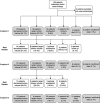When Is the Optimum Radiological Response to Proton Beam Therapy in Uveal Melanoma?
- PMID: 38089179
- PMCID: PMC10712970
- DOI: 10.1159/000533308
When Is the Optimum Radiological Response to Proton Beam Therapy in Uveal Melanoma?
Erratum in
-
Erratum.Ocul Oncol Pathol. 2024 Apr;10(1):63. doi: 10.1159/000537728. Epub 2024 Feb 20. Ocul Oncol Pathol. 2024. PMID: 40144679 Free PMC article.
Abstract
Introduction: Proton beam therapy (PBT) is an effective treatment option for uveal melanomas. Following treatment, it may take many months for the tumour to respond and it may initially enlarge. We reviewed our PBT patients to determine when they showed a radiological response to treatment.
Methods: Patients undergoing PBT for ciliary body or choroidal melanomas between 2008 and 2018 were included. Data were collected on patient demographics, treatments before and after PBT and survival. All ultrasound investigations prior and since PBT were reviewed and tumour volume calculated using a validated formula for a half-ellipsoid shape.
Results: 193 patients were analysed, 169 with choroidal and 24 with ciliary body melanomas. 31.6% patients had other treatment prior to PBT. At a mean of 8 months post-PBT, 64.7% of patients had a reduced tumour volume with 20.2% having larger tumours. At a mean of 15 months post-treatment, these figures were 67.8% and 10.3%. 18.1% of patients had an enucleation during the study period. The earliest responses were seen at 2 months, the latest at 32 months post-treatment. 5-year melanoma-specific survival was 82.3%.
Conclusions: In our study, by 6 months post-PBT, a majority of patients show a reduction in tumour volume. Of those that do not, many respond in the next 6 months and a response may be seen up to 32 months after treatment. Patients may need to be monitored for up to 32 months to see a final response to PBT treatment.
Keywords: Proton beam therapy; Radiological response; Uveal melanoma.
© 2023 S. Karger AG, Basel.
Conflict of interest statement
The authors have no conflicts of interest to declare.
Figures
References
LinkOut - more resources
Full Text Sources




